Langali – Gloriosa superba Uses, Research, Side Effects
Langali- Gloriosa superba is a plant mentioned in Ayurveda for the treatment of wound, swelling, skin disease, bite from poisonous animals, difficulty during labor, intestinal worms etc.
Latin name- Gloriosa superba Linn.
Family- Liliaceae(Rasona kula)
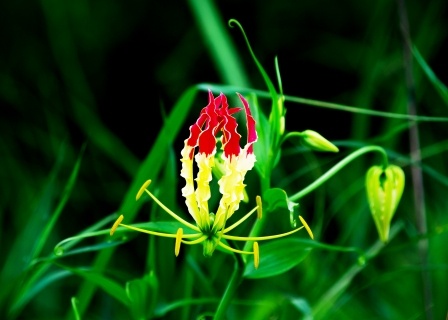
Table of Contents
Vernacular names
Names in different languages:
Hindi name- Kalihari
English name- Malabar glory Lily, Tiger’s claw, Climbing Lily
Bengali name- Ulatchandal
Gujarati name- Dhoodiyo bachnag
Kannada name- Gouri gadde
Marathi name- Kalalavi
Malayalam name- Medoni
Tamil name- Kalai pai
Telugu name- Adavinabhi
Sanskrit synonyms
Sanskrit Synonyms of Kalihari:
Agnishika- The flowers have bright red color like fire
Raktapushpa- Flowers are red like blood
Garbapatini/ Garbanuth- The herb expels the fetus
Halini- The tuber resembles that of plough
Shukrapushpi, Indrapushpi – beautiful flowers
Vahnijihva, Vahni Vaktra, Pradeepta, Vahnimukhi, Agnishikha – flowers resemble flame
Kalihari – Langali may be used in Surgical emergencies
Siri, Vishalya, Kalikari, Prabhata, Pushpaseebhara
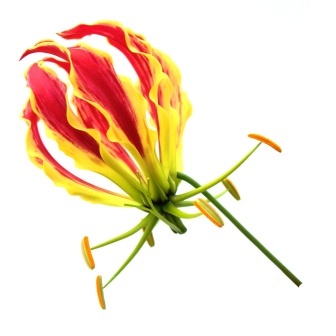
Morphology
Morphology Gloriosa superba:
Langali is a climber with a soft stem. The leaves are about 6-8 inch long and 2-3 inch wide, shiny in nature. They are mainly alternately arranged, but they may be opposite, as well. They are somewhat lance-shaped and tipped with tendrils. The flowers are attractive with a combination of bright red and yellow colors and having finger-like appearance. They are seen in the rainy season. The fruits are about 2-4 inches long with reddish seeds inside. The rhizome is fleshy and grows to a length of about 1 foot and 1-2 inch thick. It has an appearance like a plough. The plant is found all over India in the temperate climate.
Varieties
2 types – Male and Female
Different species –
1. Gloriosa superba
2. Gloriosa rothchilidiana
3.Gloriosa planti
4.Gloriosa lutea
5. Gloriosa causuariana
6. Gloriosa vucheiri
Properties, part used, dosage
Langali medicinal properties:
Rasa (Taste) – Katu (Pungent), Tikta (Bitter)
Guna (Qualities) – Laghu (Light for digestion), Teekshna (Strong)
Vipaka – Katu (Undergoes Pungent taste after digestion)
Veerya (Potency) – Ushna (Hot)
Karma (Actions) – Kaphavata shamaka (reduces vitiated kapha and vata dosha)
Prabhava (Special action)- Abortifacient
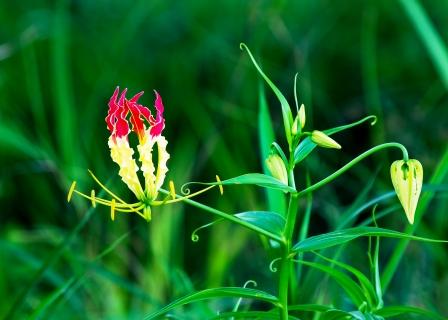
Part used- Rhizome
Dosage-
Powder- 250 to 500 mg for therapeutic use, 3-6 gm as abortifacient
Chemical composition
Chemical composition of Gloriosa superba:
The root contains colchicine. Colchicine and its derivatives are present in tubers, seeds and flowers. The seeds are used as raw material for preparing drugs for gout. They are considered a rich source of colchicine and gloriosine.
Purification method
Langali Shodhana – Purification:
Since Langali is considered as Upavisha (herb containing poisonous constituent) according to ayurveda, it is purified by boiling the rhizome of Langali in cow milk for 3 hours. After this procedure, the rhizome can be used for therapeutic benefit. This procedure is called Ksheera Swedana.
As per Ayurveda Prakasha, 6/50/
Langhli – 1 part
Cow urine – quantity sufficient is taken.
Method: Small pieces of roots of langli are soaked in gomutra for 24 hrs then washed off.
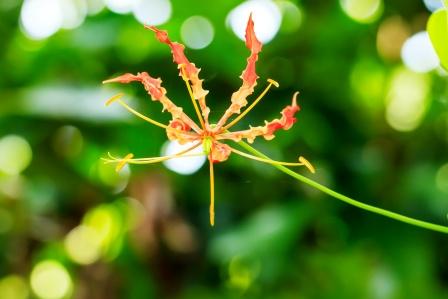
Uses, Sanskrit verse
Medicinal Uses of Langali:
- The paste of the rhizome of Langali is applied externally to treat cases of scorpion bite, sting of bee, centipede bite.
- The paste of the rhizome of Gloriosa superba is applied over the area affected with skin disease, external pile mass, wound and localized swelling over joints.
- The paste of Langali is applied over the umbilical area or given internally in a dose of 3-6 g to cause abortion by stimulating the uterine muscles.
- The fresh juice of the leaves of Langali is applied over the scalp region to kill head lice.
- In a dose of 250-500 mg, the powder of rhizome of Gloriosa superba is mixed with milk and consumed to give strength to the body.
- In a dose of 500-750 mg, the powder of Langali is given with hot water to treat cases of intestinal worms.
- Dosage of 1-1.5 g of rhizome powder is used to treat fever and improve the appetite.
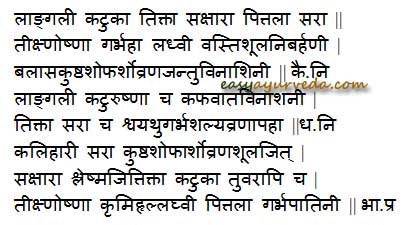
Uses of Kalihari as per Ayurveda:
Kshara – alkali, strong, cutting, piercing
Pittala – Increases Pitta Dosha
Sara – induces mobility, causes diarrhea, purgation, relieves constipation
Teekshna – strong, piercing
Ushna – hot
Garbhaha – abortifacient
Indications
Traditionally indicated in
Bastishoola – Urinary bladder pain
kapharoga – Kapha disorders
Kushta – skin diseases
Shopha – inflammation
Vrana – Ulcers, wounds
Jantu – worm infestation
Adverse effects
Adverse effect of Kalihari:
The tuber can stimulate the uterine muscles, thus leading to abortion.
Hence the herb is to be avoided internally by pregnant ladies.
Increased dosage can also cause vomiting, diarrhea and increase in blood pressure.
Interaction with medicines, supplements
Can this be used while taking Homeopathic medicine?
Yes. This product does not react with homeopathic medicine.
Can this medicine be continued while taking supplements like multivitamin tablets, Omega 3 fatty acids etc?
Yes. Generally, this product goes well with most dietary supplements. However, if you are taking more than one product per day, please consult your doctor for an opinion.
With western
medicines
Seek your
doctor’s advice if you are taking this product along with other western
(allopathic / modern) medicines. Some Ayurvedic herbs can interact with modern
medicine.
If both Ayurvedic and allopathic medicines are advised together, then it is
best to take Allopathic medicine first, wait for 30 minutes and then take the
Ayurvedic medicine.
Ayurvedic medicines
Ayurvedic medicines containing Langali:
Kalakuta Rasa: This medicine is used in the treatment of chronic fever, chronic bronchitis, cough, urinary tract disorders, diabetes etc.
Brihat marichadi taila: It is used in the treatment of deafness, paralysis, locked jaw, neck stiffness, dwarfism, low back ache, spondylosis, sciatica, and such other vata disorders.
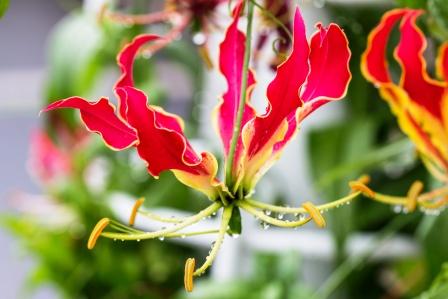
Chitrakadi taila: It is used to apply externally into the fistula tract to induce quick healing.
Munipile oil: It is a proprietary Ayurvedic medicine useful to treat piles, fistula, hemorrhoids and constipation.
Research
Research articles related to Gloriosa superba:
Effect on reproductive system:
The objective of the study was to evaluate the activity of the aqueous extract of Gloriosa superba (AL) root on the female reproductive system of rats. Phyto-chemical analysis shows presence of flavonoids, tannins, alkaloids, and glycosides in the aqueous extract of Gloriosa superba. Antifertility study showed early abortifacient activity. No increase in uterus and ducidual weight was observed. Both the reference (oxytocin) and the extract produced dose-dependent contractions but the extract had no effect on heart parameters and blood pressure.
Anti- ulcerogenic action:
The present study was carried out to investigate the antiulcerogenic activity of ethanolic extract of Gloriosa superba L. tuberous (GST) rhizomes. The anthelmintic activity of various extracts of GST was also evaluated in vitro against two types of intestinal worms; a) Earthworms and b) Ascardia Galli (a parasitic roundworm). GST extract showed superior protection when compared with other test extracts on both the ulcer models tested. The extract significantly increased the pH and decreased both the volume and total acidity of gastric secretion in pylorus ligation-induced ulcer model.
Anti- inflammatory activity:
Gloriosa superba L. (Liliaceae) seeds, known as “kalihari” (Hindi), were phytochemically investigated for colchicine (well known for gout treatment) and other related alkaloid content. The compounds were subjected to an anti-inflammatory study by using the formaldehyde inflammagen-induced inflammation model. The results clearly indicated that the colchicine is more effective as an anti-inflammatory agent compared with phenylbutazone, the standard drug used in the study.
Classical categorization
Bhavaprakasha- Guduchyadi varga
Dhanvantari Nighantu- Karaveeradi varga
Kaiyyadeva Nighantu- Oushadhi varga
Scientific classification
Kingdom: Plantae
Order: Liliales
Family: Colchicaceae
Genus: Gloriosa
Species: G. superba
Author: Dr.B.K.Prashanth M.D (Ayu), Ph.D
E mail: [email protected]
Click to consult Dr Prashanth BK
Systemic Action (Sthanika Karma)
External – External application is indicated in swelling, Hemorrhoids, wounds, Cervical lymphadenopathy, skin diseases, Scorpion bite etc. . Ant helminthic, Abortifacient. After child labor, for the separation of placentae, it is advised to apply langali stem paste over the hands, legs, umbilical area and lower abdomen. In olden days its stem was inserted into the vagina to facilitate the labor process.
Digestive System – In lower dose it has carminative, Anthelmintic action. Overdose can cause vomiting and purgation and burning sensation in the stomach and intestine. In lower doses it can be given in people suffering from low digestive power, Helminthiasis, etc.
Circulatory system – Acts as a blood purifier. Indicated in skin disorders
Reproductive System – Help to contract uterine muscles. Its powder can be used in conditions like delayed labor etc.
Tapakrama – Indicated in Vishamajvara
Satmikarana – In lower doses it can be used to promote body strength.










